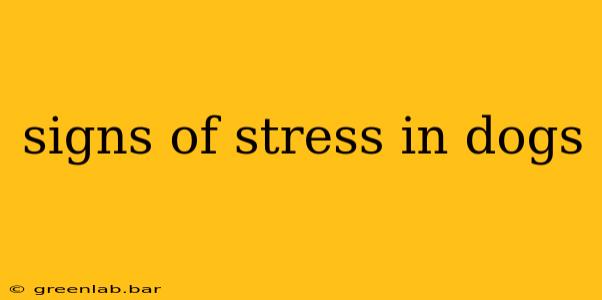Dogs, our beloved companions, can't verbally express their feelings. Understanding the subtle and overt signs of stress in dogs is crucial for responsible pet ownership. Recognizing these signals allows us to provide the necessary support and prevent escalating anxiety. This comprehensive guide will help you identify common stress indicators in your canine friend, enabling you to create a happier and healthier environment.
Behavioral Signs of Stress in Dogs
Stress manifests differently in dogs, ranging from subtle changes in behavior to more pronounced displays of anxiety. Recognizing these signs early is key to effective intervention.
Subtle Signs:
- Changes in Sleeping Patterns: A sudden increase or decrease in sleep, restless sleep, or difficulty settling down can indicate underlying stress. Is your usually cuddly dog suddenly avoiding your lap? This could be a subtle stress signal.
- Increased or Decreased Appetite: Significant changes in eating habits—either overeating or refusing food—often signal distress. Observe your dog's eating patterns carefully.
- Excessive Panting or Yawning: While panting is normal after exercise, excessive panting or yawning, even when resting, can suggest stress or anxiety.
- Changes in Social Interaction: A typically playful dog becoming withdrawn, hiding, or avoiding interaction with family members or other pets can be a crucial warning sign.
- Licking or Chewing: Excessive licking of paws, legs, or other body parts, or increased chewing on furniture or objects, can be self-soothing behaviors associated with stress.
More Overt Signs:
- Restlessness and Pacing: Constant pacing, inability to settle, or restlessness even in familiar surroundings suggests significant anxiety.
- Destructive Behavior: Digging, chewing, or tearing up belongings can be an outlet for pent-up stress and anxiety.
- Vocalization: Excessive barking, whining, howling, or whimpering, particularly when seemingly unprovoked, can indicate stress.
- Aggression: While not always a direct sign of stress, aggression can be a manifestation of fear or anxiety in some dogs. This requires immediate attention and professional guidance.
- Changes in Posture: A tucked tail, lowered head, flattened ears, or a hunched posture often indicates fear or submission, which are responses to stress.
Physical Signs of Stress in Dogs
Beyond behavioral cues, stress can manifest physically in your dog. These physical signs should not be overlooked:
- Vomiting or Diarrhea: Stress can significantly impact a dog's digestive system, resulting in gastrointestinal upset.
- Changes in Urination or Defecation: Increased frequency or accidents in the house can point to underlying anxiety.
- Dilated Pupils: Wide, dilated pupils can be a visible sign of a dog's heightened stress response.
- Shaking or Tremors: Uncontrollable shaking or tremors, especially in the absence of cold or illness, can indicate significant anxiety.
Addressing Canine Stress
Once you've identified signs of stress, taking proactive steps is crucial:
- Identify the Trigger: Pinpointing the source of stress (e.g., loud noises, new environments, changes in routine) is the first step toward addressing the issue.
- Provide a Safe Space: Create a quiet, comfortable den where your dog can retreat when feeling overwhelmed.
- Positive Reinforcement Training: Use positive reinforcement techniques to help your dog manage stressful situations.
- Enrichment Activities: Engage your dog in mentally stimulating activities like puzzle toys or training sessions to reduce boredom and anxiety.
- Consult a Veterinarian: If you suspect your dog is experiencing significant stress, consult your veterinarian to rule out any underlying medical conditions. They may also recommend a certified veterinary behaviorist.
Conclusion: A Happy, Healthy Dog
By understanding the subtle and overt signs of stress in dogs, we can create a more supportive and enriching environment for our canine companions. Early recognition and intervention are key to preventing anxiety from escalating and ensuring a happy and healthy life for your furry friend. Remember, a stressed dog is not a happy dog. Be vigilant, be attentive, and prioritize your dog's well-being.

